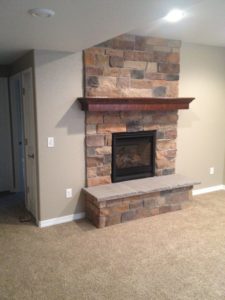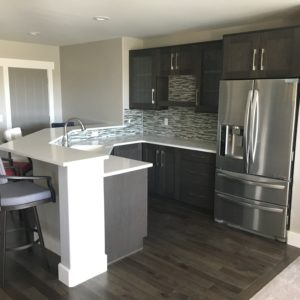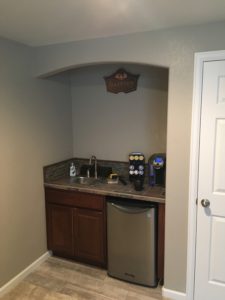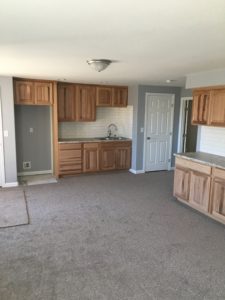"I would like to finish my basement. What is the process?"
First, you will need to contact us to schedule a time when we can meet.
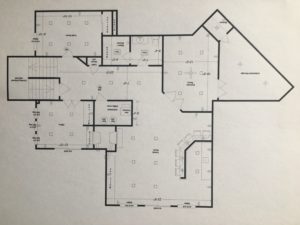 At our initial meeting we will measure your basement space and discuss what you’d like to have included in your basement design.
At our initial meeting we will measure your basement space and discuss what you’d like to have included in your basement design.
When we return for our second visit we will present to you a proposal which will include one or two floor plan options, and a very detailed outline of everything that would be included in your basement project. We will then tweak the floor plan and proposal to your satisfaction.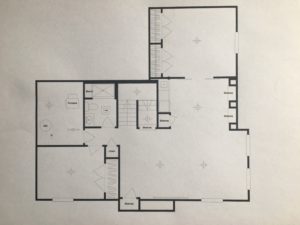
If you elect to move forward, and once a contract is signed, you will need to make sure that your basement is 100% empty.
We will go to the building department and pull all of the required permits, and your project will begin within 3-5 business days of your signing the contract.
![]()
"If you want it built better, get a Better Built Basement!"
"Who should pull the permits for my basement finish?"
 A legitimate basement contractor will pull the permits himself.
A legitimate basement contractor will pull the permits himself.
There are a number of basement finishers that suggest a homeowner pull the permits, telling them that it is cheaper for the homeowner to do so. This is a blatant lie and should be considered a huge ‘red flag’ warning. The cost is the same, whether the contractor or the homeowner pulls the permits, and it takes a very short amount of time for the contractor to go to the building department to do so.
In El Paso county, it is required by law for a basement finisher to be a licensed general contractor. Typically, the individual who suggests that the homeowner pull the permit is doing so because he does not hold a contractor's license and is unable to acquire one. There are only two reasons an individual cannot acquire a general contractor’s license. 1st, he doesn’t have the knowledge, expertise and ability to pass the test which is required to obtain the license. 2nd, he had a license and lost it because of shoddy business practices. The reason that individual is telling you that it would cost more for him to pull the permits is because due to his not having a license, he has to pay someone else who does hold a license to pull the permit for him. This is an illegal practice. 
The building department has processes in place to protect the homeowner from unethical contractors. After passing and complying with all testing requirements, when obtaining a contractor's license it is necessary to have insurance in place. If a contractor's insurance lapses, licenses are pulled until insurance is reinstated. This insures that the homeowner is protected. Unlicensed individuals posing as contractors typically have no insurance in place to protect the homeowner. If one of their people is injured while on the job, the homeowner can be sued.
I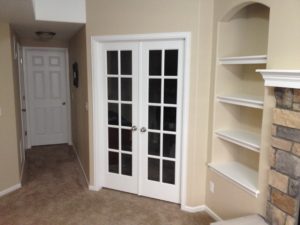 t is also important to keep in mind that if the unlicensed contractor has an unlicensed electrician working on a home and it burns down, the insurance company is not going to want to cover the cost of that loss because the homeowner hired an unlicensed uninsured individual. Why should they have to pay for the homeowner's poor decision to hire an unlicensed contractor? This is a perfect example of putting oneself in a bad liability situation.
t is also important to keep in mind that if the unlicensed contractor has an unlicensed electrician working on a home and it burns down, the insurance company is not going to want to cover the cost of that loss because the homeowner hired an unlicensed uninsured individual. Why should they have to pay for the homeowner's poor decision to hire an unlicensed contractor? This is a perfect example of putting oneself in a bad liability situation.
All of the subcontractors, if working under a legitimate licensed general contractor, will be licensed and insured in their individual areas of expertise. This insures that the homeowner is protected.
![]()
"If you want it built better, get a Better Built Basement!"
"Once I have signed the contract, is the price of my basement finish going to escalate?"
 Absolutely not.
Absolutely not.
Basement finishing is a very competitive market. There are many unscrupulous individuals who, in an effort to seal the deal will give low-ball bids that the potential customer cannot resist. The unfortunate truth is, if something sounds too good to be true, it most likely is.
Contractors who present unrealistically low bids do so with every intention of adding on costs throughout the project, knowing that the customer with whom they have signed a contract will feel obligated to accept cost variations. 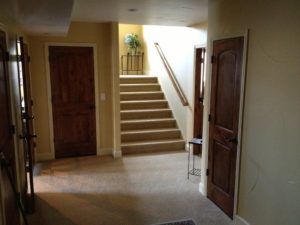
We at Better Built Basements, Inc. have never gone to a customer with an unexpected cost increase stating that 'we missed this or that and now have to change the price'. We have a clause in our contract stating that the contract cost will never change, as long as the homeowner does not change the conditions of the contract. For example, the only time the cost will change is if the homeowner makes a decision during the construction process to make an upgrade or addition to the project.
![]()
"If you want it built better, get a Better Built Basement!"
"Should I add additional insulation to my basement walls?"
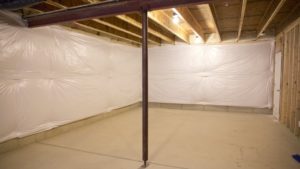 Most concrete foundation walls in unfinished basements have a vinyl wrapped insulating blanket secured to the walls. This is a code requirement in most local municipalities and is all that is required by code as far as insulating that area. Codes are the minimum requirements of local county, state and federal statutes that are accepted and enforced by the local building departments and officials. You are not required to add any additional insulation to the foundation walls.
Most concrete foundation walls in unfinished basements have a vinyl wrapped insulating blanket secured to the walls. This is a code requirement in most local municipalities and is all that is required by code as far as insulating that area. Codes are the minimum requirements of local county, state and federal statutes that are accepted and enforced by the local building departments and officials. You are not required to add any additional insulation to the foundation walls.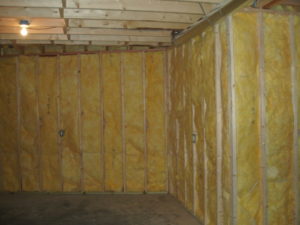
Insulation is rated by an assigned “R” value. The R stands for Resistivity to heat loss. The R value of the vinyl wrapped insulating blanket secured to the foundation wall is R-11. This is a relatively low R value for a house wall. One additional consideration is the fact that a considerable amount of that foundation is typically below grade, which has a good insulating effect.
For those who are interested, an additional 3½” of high density fiberglass R-15 insulation may be placed in the 2 x 4 framed walls that are going to be placed immediately adjacent to the concrete foundation walls around the perimeter of the basement. This will result in the walls having a total R-26 value. This will help to reduce heating and cooling costs in the basement area, and over time will result in a savings on utilities as well. Some studies suggest a savings of $200.00 to $400.00 per year depending on the climate zone in which one lives. We always ask our customers how long they plan on keeping their home. The cost of insulating the foundation walls will eventually be recouped due to the savings in utility costs. However, if cost is an issue it is not necessary to add additional insulation in those walls.
![]()
"If you want it built better, get a Better Built Basement!"
"What about the basement ceiling? Should I insulate it to provide soundproofing?"
There are a number of contractors who will try to convince a customer that insulating a basement ceiling will help to keep the noise down in the basement.
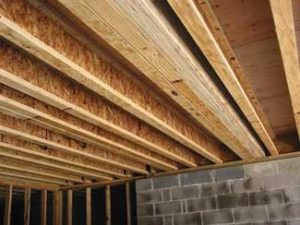 Insulating a basement ceiling provides a very minimal benefit. In many instances while on the 2nd floor of the home, homeowners can listen to conversations and hear their children playing in the basement because sound resonates through all of the framing materials, mostly traveling through the heat and cold air ducts.
Insulating a basement ceiling provides a very minimal benefit. In many instances while on the 2nd floor of the home, homeowners can listen to conversations and hear their children playing in the basement because sound resonates through all of the framing materials, mostly traveling through the heat and cold air ducts.
Only in extreme situations would we ever suggest insulating the joists in the basement ceiling. For instance, if one works nights and is going to be sleeping in a basement bedroom, there may be some value (though minimal) in insulating the bedroom ceiling. 
We make every effort to help our customers make educated decisions. In our opinion it is a waste of money to insulate the ceiling joists. We have been building for a lifetime and have never see insulation placed between the 1st and 2nd floors of a home. Why would it be necessary to insulate between the basement and the main floor?
![]()
"If you want it built better, get a Better Built Basement!"
"Will I be required to upgrade my primary electrical service panel as a result of finishing my basement?"
Many builders, especially those building homes 10 to 15 yrs ago, put the smallest electrical service panels they could get away with in the new homes of the time. We often find these panels in older homes. They simply took care of the current need and did not care about the future needs of the homeowner. We also find that there are some very dangerous primary Electrical panels in some of even older homes that are defective and have a history of failure. These would definitely need to be upgraded.
We similarly find that many of the panels in homes being built today are full. In either case this often requires the addition of a sub-panel or in extreme cases a complete service upgrade when necessary. Our electrician performs load calculations that determine the size of the electrical panel that is required by code. This information is then shared with the home owner along with a thorough explanation before making any decisions. If it is determined that a service panel upgrade is required, we will make sure that future need is taken into consideration.
![]()
"If you want it built better, get a Better Built Basement!"
"I already have an Egress window in the main area of my basement. Do I need more than one?"
Current code requires that there be one egress window and window well (36” projection off the face of the window) in an unfinished basement. When finishing the basement that requirement often changes depending on a number of circumstances.
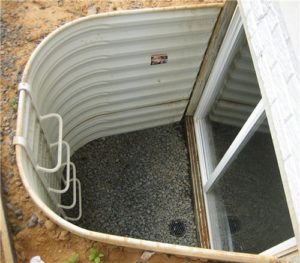 The requirement of only one window well in an unfinished space no longer applies if multiple bedrooms are built in that space. Each bedroom is required to have its own egress window, window well and ladder. Egress windows are not required in the remainder of the basement.
The requirement of only one window well in an unfinished space no longer applies if multiple bedrooms are built in that space. Each bedroom is required to have its own egress window, window well and ladder. Egress windows are not required in the remainder of the basement.
Homes built prior to the year 2000 required a 30” window well, which requirement is grandfathered in when finishing a basement in one of these homes today. Any home built in the year 2000 or after requires a 36” window well.
In an effort to pinch pennies and save a few dollars on the homes they built, many builders in the past installed only one basement egress window well. It is often necessary to remove and replace one of the installed smaller window wells if it happens to be in a bedroom location. This ends up being very expensive. In recent years that practice has changed and many of the better builders make certain that there is more than one egress window well when building a home.
![]()
"If you want it built better, get a Better Built Basement!"
"How can I get rid of the closed in 'tunnel feeling' at the bottom of my basement stairs?"
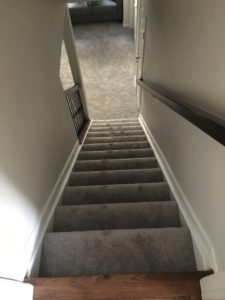 On occasion we find that there is a door at the bottom of the basement stairs. When deciding whether or not to
On occasion we find that there is a door at the bottom of the basement stairs. When deciding whether or not to 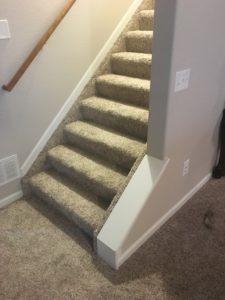 remove the door, the following may be taken into consideration:
remove the door, the following may be taken into consideration:
1) A door at the base of the stairs provides privacy, noise control and heat retention. 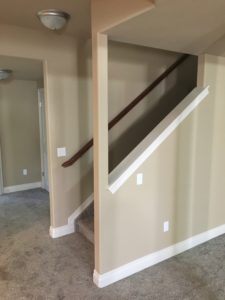
2) Is a door necessary? A door is not typically used to separate a first floor and second floor of a home, and is not needed to separate the basement from the rest of the home.
It is often determined to remove the door at the bottom of the stairs to give a more open and spacious feeling.
To eliminate the closed in ‘tunnel feeling' at the base of an open stairwell, you can remove part of the wall to expose approximately 3 treads, or open the wall approximately 4-5’ at the base of the stairs and have either a short wall or open railing and spindles in that area. 
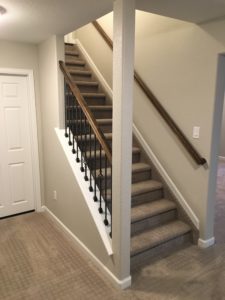 On occasion we find that there is a door at the top of the stairwell that a customer wants to have removed. The best way to accomplish this is to simply remove the door, hinges and lock plate. A good quality two-part epoxy wood filler is best for filling the resulting voids in the door jam. When properly done, little or no sign of pre-existing voids can be seen. By using this avenue, it minimizes the amount of work needed to accomplish an opening at the top of the stairs.
On occasion we find that there is a door at the top of the stairwell that a customer wants to have removed. The best way to accomplish this is to simply remove the door, hinges and lock plate. A good quality two-part epoxy wood filler is best for filling the resulting voids in the door jam. When properly done, little or no sign of pre-existing voids can be seen. By using this avenue, it minimizes the amount of work needed to accomplish an opening at the top of the stairs.
![]()
"If you want it built better, get a Better Built Basement!"
"How can I best utilize the space under my basement stairs?"
Under stair space is often used for storage, and while we have inserted a linen or game closet into the space for many of our customers, we often suggest to those with small children or grandchildren that they consider converting the space into a special children’s play area, where their little ones' imaginations can run wild.

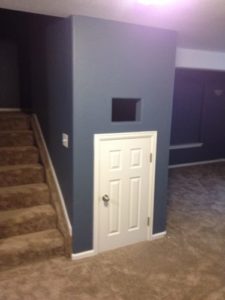 T
T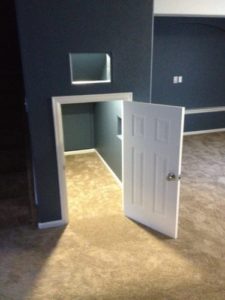 his can be done in a variety of ways. The most popular is to install a small door and window opening. On occasion we have installed a small roof line over the door with shutters flanking the window. This provides a fun space for the children to play where they can be easily supervised.
his can be done in a variety of ways. The most popular is to install a small door and window opening. On occasion we have installed a small roof line over the door with shutters flanking the window. This provides a fun space for the children to play where they can be easily supervised.
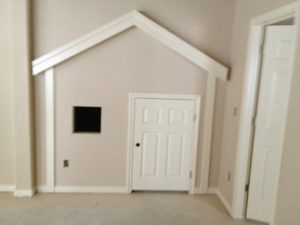
Painting an interior wall with chalkboard paint in the space provides little artists a canvas to freely express themselves.
In some instances, we have installed hand and toe holds on the tall wall, converting it to a climbing wall. One-inch rigid foam flooring that fits together like pieces of a puzzle is often used to protect the little ones from the hard concrete floor.
Some customers opt to convert the under stair space into a reading nook. In those instances we open the area and install a platform that will hold a twin size mattress. A set of shelves is inset into the side wall, special lighting and a receptacle for charging phones and games completes the space. This cozy nook not only provides a comfy place to curl up and relax, it can also be used as an inviting space for overnight guests.
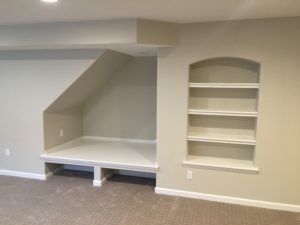

Whether the space is to be left open or enclosed, converted into a playhouse or a reading nook, enjoyed by adults or by our tiniest of clients; the sky is the limit when it comes to designing this wonderful and often underutilized space.
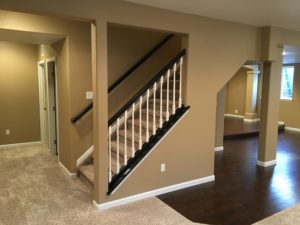
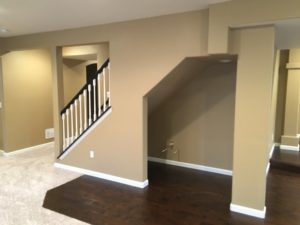
![]()
"If you want it built better, get a Better Built Basement!"
"Is it possible to install a fireplace in my basement?"
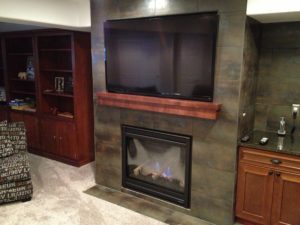
We have installed many basement fireplaces, most of which are gas units. These fireplaces can range in efficiency from a basic unit which puts out a minimal amount of heat but satisfies one’s need for aesthetics, to furnace grade units which will put out a good amount of heat and have all the bells and whistles.

There are many finishes available for fireplaces ranging from basic tile, which is found in many area track homes, to elaborate stone facings with beautiful stone hearths.
For those who are on tight budgets, electric units are available which give the look and feel of a standard fireplace at a comparatively very reasonable cost.
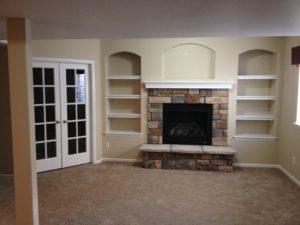
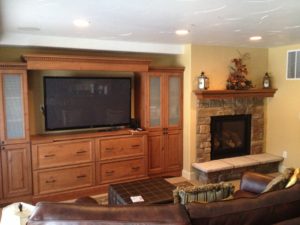
![]()
"If you want it built better, get a Better Built Basement!"
"Can I have a Wet Bar in my basement?"

A Wet Bar can easily be added to your basement. We offer a wide variety of designs that range from simple and basic, to very grand and opulent. Your beautiful Wet Bar area will be designed to perfectly reflect your style and esthetic.
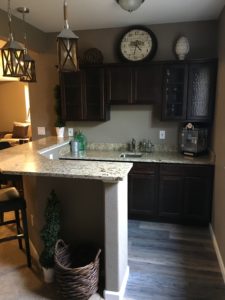
When planning your wet bar area, keep in mind that although microwaves and countertop appliances are permitted, local building codes prohibit the installation of a range, oven or cook top. However, if your basement is being finished to accommodate an elderly or handicapped family member and hardship can be proven, the building department may make an exception due to these extenuating circumstances and a variance may be acquired.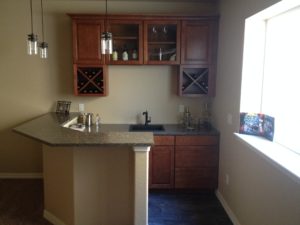
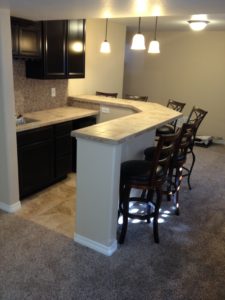
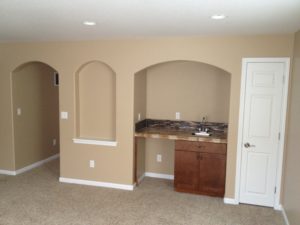
![]()
"If you want it built better, get a Better Built Basement!"
"What type of flooring is best for my basement?"
 There are so many types of flooring available that for the most part it boils down to one’s personal preference.
There are so many types of flooring available that for the most part it boils down to one’s personal preference.
Concrete floors typically found in a basement create a unique set of challenges when considering flooring.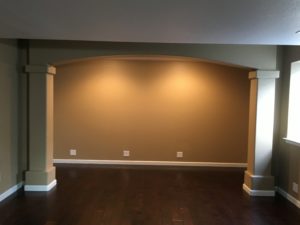
Most of the time a good quality carpet and pad are the best option, as they help to mitigate many of these problems. For those who want a laminate or similar flooring, oft times concrete has to be ground and/or filled in order to provide the proper surface for the installation of these types of flooring.
Ceramic tile is often used in wet bar and bathroom areas. It can also be used throughout the basement when circumstances allow.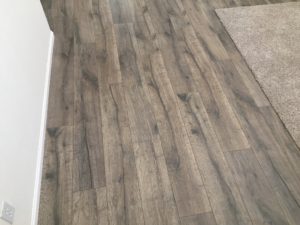
Flooring choice depends heavily on the basement floor condition.
![]()
"If you want it built better, get a Better Built Basement!"
"How do I conceal my sump pit?"
A great number of basements have sump pits with sump pumps in place which were furnished by the original home builder. We often find a sump pump has never been installed in the pit, and in those situations, we strongly suggest the installation of a pump. It is a small price to pay to help guard against your basement flooding.
Sump pits are often installed in the utility room where it isn’t an issue. Unfortunately, many times sump pumps are installed in a corner or other random location of the basement. In those instances, a closet can be built around the sump pit or a more decorative set of shelves can be constructed to conceal it. It can also be incorporated into a wet bar area where a standard kitchen cabinet conceals the sump pit. Every space is unique.
A STRONG WORD OF CAUTION: A sump pump pit is a very deep, narrow cylindrical hole that can be anywhere from 3' to 6' deep and often has several inches of standing water at the bottom of the pit. This should be considered an attractive nuisance which is very dangerous for small children. Sump pump lids are very light and simply set into place. A curious child could easily remove the lid, fall into the pit and become seriously injured or drown. To prevent such a tragedy, homeowners can easily secure the lid by simply installing a few screws through the rim of the casing into the lid, ensuring that a child will never be able to disengage the lid to access the pit.
![]()
"If you want it built better, get a Better Built Basement!"
"Are there aspects of the work I can do myself to save money?"
Absolutely. We would be happy to discuss the pros and cons of different aspects of the work that you might do yourself to help save money on your basement project.
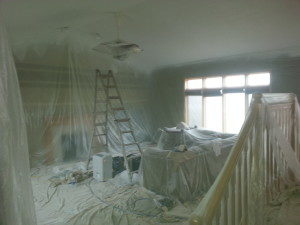 When deciding whether or not to do portions of the project yourself, it is important to consider whether you have the skill set necessary to complete the work.
When deciding whether or not to do portions of the project yourself, it is important to consider whether you have the skill set necessary to complete the work.
For example, we recently had a homeowner do the complete electrical and plumbing rough-in and finishes on his basement. That individual was wholly capable and had the skills needed to do a fine job.
On the other hand, we have had some customers over the years who have chosen to paint their own basement, resulting in a less than desirable basement finish.
Time is another consideration. Because of family or work obligations, most homeowners have very little time to dedicate to working on their basement. They are usually able to work an hour or two at a time, significantly delaying completion of their basement project. 
It often takes days or weeks longer for a homeowner to finish an aspect of the job that would typically take a professional and his crew an afternoon to finish.
![]()
"If you want it built better, get a Better Built Basement!"
"Can I hang and finish my own drywall?"
 often have customers suggest that they’d like to do their own drywall to save money.
often have customers suggest that they’d like to do their own drywall to save money.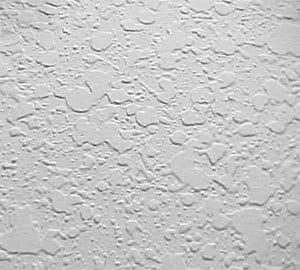
![]()
"If you want it built better, get a Better Built Basement!"
"Can I have the rough-ins done and finish the work myself?"
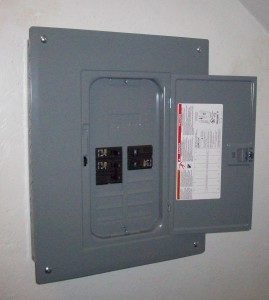 It would be very difficult to find a sub-contractor who would be willing to pull a permit and do the job half way, then allow the homeowner to finish the work. Doing so would place a considerable amount of liability on the sub-contractor, which he would not be willing to incur.
It would be very difficult to find a sub-contractor who would be willing to pull a permit and do the job half way, then allow the homeowner to finish the work. Doing so would place a considerable amount of liability on the sub-contractor, which he would not be willing to incur. 
Case in point: If an electrical contractor did the rough in on a job and allowed the customer to hook up all the switches, receptacles and light fixtures and something happens ... there is an electrical arc which causes the house burn down ... whose insurance would cover the loss? How would it be determined who was at fault? 
It would be a foolish contractor who would be willing to take on the risk. 
![]()
"If you want it built better, get a Better Built Basement!"
"Our finances are tight and we would like to finish our basement in segments. Is that possible?"
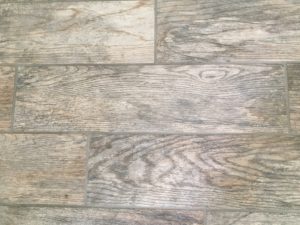 The best and most cost-effective approach to doing a basement finish is to wait until you have the money and do it all at once.
The best and most cost-effective approach to doing a basement finish is to wait until you have the money and do it all at once. 
There are a number of negative aspects to segmenting a basement finish.
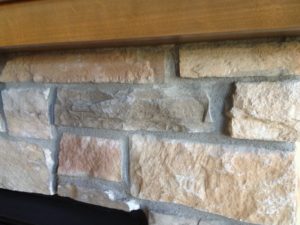
When the framing is done, if it is not covered with drywall in a reasonable amount of time, the studs have a tendency to twist, bow and warp. Covering the framing with drywall in a timely manner negates that issue.

Each of the trades do an initial rough-in and then follow up by coming back a second time to finish their aspect of the work after other work has been completed. By segmenting the project, it greatly increases the time element and permits will most likely expire, resulting in additional costs to extend the permits. Building permits are subject time limitations, so the work needs to be done in a timely manner to keep from paying additional costs of reissuing or extending the permits.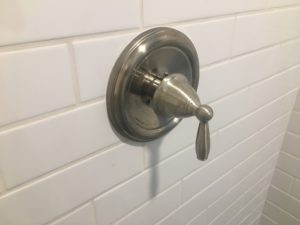
It is very frustrating for sub-contractors to start work and not be able to finish it in a timely manner, and segmenting a project prevents them from doing so.
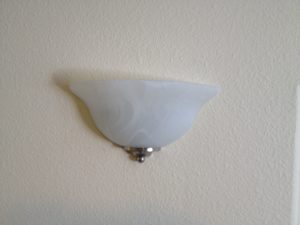 It creates a cash flow issue for them, as they have their time, energy and materials tied up in a project on which they are unable to receive payment until the work is completed.
It creates a cash flow issue for them, as they have their time, energy and materials tied up in a project on which they are unable to receive payment until the work is completed.
![]()
"If you want it built better, get a Better Built Basement!"
"Who should I hire to finish my basement?"
There are many builders in the area who are capable of finishing basements. It is our hope that you will give us an opportunity to finish your basement space. All of our people are very cordial and go out of their way to ensure that our customers are satisfied with their work and their work ethic.
Having over 70 years of combined experience, Jared and John will help to ensure that you get exactly what you want ... the basement of your dreams.
The bottom line is ... "If you want it built better, get a Better Built Basement!"
![]()
